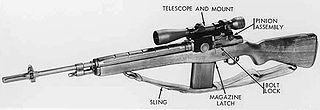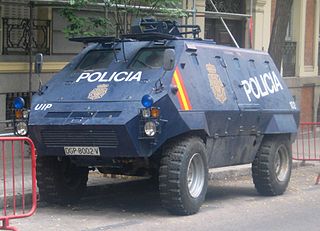
The Armed Forces of El Salvador are the official governmental military forces of El Salvador. The Forces have three branches: the Salvadoran Army, the Salvadoran Air Force and the Navy of El Salvador.

The Chapultepec Peace Accords were a set of peace agreements signed on January 16, 1992, the day in which the Salvadoran Civil War ended. The treaty established peace between the Salvadoran government and the Farabundo Martí National Liberation Front (FMLN). It was signed in Chapultepec Castle, Mexico.

The M21 Sniper Weapon System (SWS) in the US Army is a national match grade M14 rifle, selected for accuracy, and renamed the M21 rifle. The M21 uses a commercially procured 3–9× variable power telescopic sight, modified for use with the sniper rifle. It is chambered for the 7.62×51mm NATO cartridge.

The M67 recoilless rifle is a 90 mm anti-tank recoilless rifle made in the United States and later in South Korea. It could also be employed in an anti-personnel role with the use of the M590 antipersonnel round. It was designed to be fired primarily from the ground using the bipod and monopod, but could also be fired from the shoulder using the folded bipod as a shoulder rest and the monopod as a front grip. The weapon was air-cooled and breech-loaded, and fired fixed ammunition. It is a direct fire weapon employing stadia lines to allow simple range finding, based on a typical tank target bridging the lines once in range.

Carlos Humberto Romero Mena was a Salvadoran military general and politician who served as president of El Salvador from 1 July 1977 until his overthrow on 15 October 1979. Romero was the final president of the country's military dictatorship which began in 1931.

The M40 recoilless rifle is a portable, crew-served 105 mm recoilless rifle made in the United States. Intended primarily as an anti-tank weapon, it could also be employed in an antipersonnel role with the use of an antipersonnel-tracer flechette round. The bore was commonly described as being 106 mm caliber but is in fact 105 mm; the 106 mm designation was intended to prevent confusion with incompatible 105 mm ammunition from the failed M27. The air-cooled, breech-loaded, single-shot rifle fired fixed ammunition and was used primarily from a wheeled ground mount or M92 ground mount. It was designed for direct firing only, and sighting equipment for this purpose was furnished with each weapon, including an affixed M8C .50 cal spotting rifle.

The SIG Sauer SSG 3000 is a bolt-action, magazine fed rifle chambered in 7.62×51mm NATO. It was developed in Germany. It is a common law enforcement sniper rifle in both Europe and the United States. The SSG 3000 was developed by SIG Sauer GmbH and is well renowned for its high quality.

The Salvadoran Civil War was a twelve-year civil war in El Salvador that was fought between the government of El Salvador and the Farabundo Martí National Liberation Front (FMLN), a coalition of left-wing guerilla groups backed by the Cuban regime of Fidel Castro as well as the Soviet Union. A coup on 15 October 1979 followed by government killings of anti-coup protesters is widely seen as the start of civil war. The war did not formally end until after the collapse of the Soviet Union, when, on 16 January 1992 the Chapultepec Peace Accords were signed in Mexico City.

The M114 Command and Reconnaissance Carrier is a Vietnam War-era tracked armored fighting vehicle, used by the United States Army. It was manufactured by the Cadillac Division of General Motors in the early 1960s. The M114 was designed to be fast and stealthy for use in the reconnaissance role.

The T65 is an assault rifle developed and manufactured by the Combined Logistics Command of the Republic of China (Taiwan) Armed Forces in Taiwan. Originally patterned after the Armalite AR-18 that has a short-stroke gas system, the prototype unveiled in 1975 showed a rifle that is heavily influenced by the AR-15 family of rifles, albeit with modified iron sights, a reshaped stock, and redesigned handguards. The designated number '65' refers to the Year 65 of the Republic of China (Taiwan) (1976), the year the rifle's design was finalized.
The Zastava M70 is a 7.62×39mm assault rifle developed in the Socialist Federal Republic of Yugoslavia by Zastava Arms. The M70 was an unlicensed derivative of the Soviet AK-47. Due to political differences between the Soviet Union and Yugoslavia at the time, namely the latter's refusal to join the Warsaw Pact, Zastava was unable to directly obtain the technical specifications for the AK and opted to reverse engineer the weapon type. Although the M70 was functionally identical to the AK, it had unique in-built features that better enabled it to fire rifle grenades. These included a thicker receiver, a new latch for the dust cover to ensure it would not be jarred loose by a grenade discharge, and a folding grenade sight bracket over the rifle's gas block, which also shut off the gas system when raised.

The Thyssen Henschel UR-416 is a German armoured personnel carrier, first introduced in 1969 and based on the body of the Mercedes-Benz Unimog light truck.

The Salvadoran Army is the land branch and largest of the Armed Forces of El Salvador.

The FMK-3 is a selective fire blowback-operated submachine gun of Argentinian origin designed by Fabricaciones Militares in 1974. Around 30,000 were produced for the Argentinian military by 1991.

The AKM is an assault rifle designed by Soviet small arms designer Mikhail Kalashnikov in 1959. It was developed as the successor to the AK-47 adopted by the Soviet Union a decade prior.

The M18 recoilless rifle is a 57 mm shoulder-fired, anti-tank recoilless rifle that was used by the U.S. Army in World War II and the Korean War. Recoilless rifles are capable of firing artillery-type shells at reduced velocities comparable to those of standard cannon, but with greater accuracy than anti-tank weapons that used unguided rockets, and almost entirely without recoil. The M18 was a breech-loaded, single-shot, man-portable, crew-served weapon. It could be used in both anti-tank and anti-personnel roles. The weapon could be both shoulder fired or fired from a prone position. The T3 front grip doubled as an adjustable monopod and the two-piece padded T3 shoulder cradle could swing down and to the rear as a bipod for the gunner. The most stable firing position was from the tripod developed for the water-cooled Browning M1917 machine gun.
The Cashuat is an armored personnel carrier produced in El Salvador, and based on the Dodge M37B1 ¾ ton (4×4) truck.

The Salvadoran military dictatorship was the period of time in Salvadoran history where the Salvadoran Armed Forces governed the country for almost 48 years from 2 December 1931 until 15 October 1979. The authoritarian military dictatorship limited political rights throughout the country and maintained its governance through rigged elections.
The 1979 Salvadoran coup d'état was a military coup d'état that occurred in El Salvador on 15 October 1979. The coup, led by young military officers, bloodlessly overthrew military President Carlos Humberto Romero and sent him into exile. The National Conciliation Party's firm grasp on power was cut, and in its place, the military established the Revolutionary Government Junta of El Salvador (JRG). The junta was composed of two military officers and three civilians.
The final offensive of 1981, also known as the general offensive of 1981, was the unsuccessful first military offensive conducted by the Farabundo Martí National Liberation Front (FMLN) during the Salvadoran Civil War. The objective of the offensive was to initiate a popular revolution to overthrow the Revolutionary Government Junta (JRG), which had been ruling the country since the 1979 Salvadoran coup d'état. The FMLN hoped that the government would be overthrown by 20 January 1981; the date Ronald Reagan was to be inaugurated as president of the United States.



































